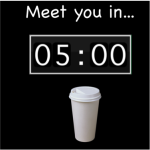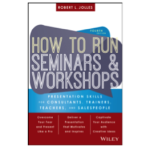 When you conduct training programs that require you to speak for long stretches of time, you have to sustain interest in your program. It doesn’t matter how strong your information may be. Without sustained interest, it’s of little value. There are many ways to accomplish this, but one of the most obvious and most valuable solutions is often overlooked. I’m referring to the simple act of taking a break.
When you conduct training programs that require you to speak for long stretches of time, you have to sustain interest in your program. It doesn’t matter how strong your information may be. Without sustained interest, it’s of little value. There are many ways to accomplish this, but one of the most obvious and most valuable solutions is often overlooked. I’m referring to the simple act of taking a break.
Breaks are often a presenter’s best friend, but not for the reason you may think. Contrary to popular belief, when a presenter takes a break, this is not a rest period for the presenter. As a matter of fact, it can be one of the most active periods of time for a presenter. There are many in an audience, particularly when it’s a big one, who are too uncomfortable to ask questions while a program is being delivered. During a break, they can walk up to the presenter and ask that question. In turn, this allows you an opportunity to connect more intimately with your audience.
No, a break isn’t just for you; it’s also for the audience. A break allows an audience to stretch their legs, grab a snack, drink some coffee, use the restroom, share information, reply to texts and emails, and generally recharge their batteries.
Another misunderstanding surrounding the idea of a break is that it should be carefully tied to a particular spot within the curriculum. Often a presenter will open an instructor guide and find the developer’s references to where to take breaks. The intent behind these references is legitimate, and typically corresponds to shifts in curriculum. So often, the mistake made by presenters is to misinterpret these suggestions. They are just suggestions – not facts. The book may tell you to break on page 25, but if the audience is drifting away on page 20, you had better think again.
Another misunderstanding centers around the preset timing of seminar breaks. A preset break refers to seminars where breaks are scheduled out at the same time every day. For example, you may be conducting a seminar that starts at 8:00 A.M. with a planned break at 9:30 A.M. That is all well and good, but once again, I am left with one question: What if the audience is falling asleep at 9:00 A.M.?

Sample Countdown Timer
What is the solution regarding breaks? Watch your audience, and read their nonverbal cues. When you notice people are fidgeting and losing focus, that’s the time for a break. You usually will not have to look too hard to pick up on when an audience needs a break. If you are pressured into breaks that are far apart, you may need to add a couple of short five-minute breaks. Insist that the trainees stick to the five minutes and start back up on time. Consider using a countdown timer within your presentation software so they are aware of the time. This helps the audience stay aware of the time, and conditions them to learn you mean business. During the short breaks, what usually happens is that those who need to run to the rest rooms will do so, and the others will just stretch and mill around. Ironically, those five minutes will probably allow you to teach more material in a day because the audience will be able to better focus on your topic.
One final technique you can use with breaks is what I call “foreshadowing.” Sometimes, an audience can come back from a break, and within 20 minutes, begin nonverbally signaling for another. You may want to say something like this: “We’ll be taking a break in a couple of minutes, so hang in there.” It doesn’t sound like much, but you would be shocked at how many of your audience members will snap back into focus because they heard the word “break.” Okay, it’s a cheap trick, but all’s fair when you’re working that room!

Coming Soon!

Great stuff, Rob! Without that timer, breaks almost always go TWICE as long as stated. “Let’s take 10” almost always turns into 20. It’s also about keeping integrity to the program: beginning on time, ending on time, taking lunch on time, and restarting from breaks on time all demonstrate and communicate professionalism and a respect for people’s time. The laggards eventually fall into line.
The other thing I’ve seen be effective and have been wanting to try is using music. The music can play ONLY during breaks or perhaps for the 1 minute that remains in a break. Either way, it serves as a signal when that music begins and/or ends … and I’ve seen people “snap to it.”
That 10 which turns to 20 creates a time crunch that’s the deliverer’s responsibility. Timer’s are great, and I always play music. But let’s try this: Music cuts out 1 minute before the break ends. I believe that awkward silence will get their attention! Thanks for the post, and the idea to try!
Well stated and practical. Thanks for the refresher.
Seems obscure, but breaks, including lunches, can represent represent up to 25% of the training we put on in a typical one-day delivery. Let’s get it right! Thanks for the post Victor.
Always appreciate your wisdom!!!
Great tips I will keep in mind>
Thanks
Peter Getoff
Yes sir – breaks can be one of the best interest sustaining ideas at our disposable, and can be the sloppiest if not handled properly. I always like to see those posts from you Peter!
The Pomedero method works well for me, it uses a 5 minute break every 25 minutes.
https://vimeo.com/94036800
While it is for getting things done and not meetings, I think that formula would work for meetings at well.
Well… I’m going have to disagree a little here. I’d rather provide something for the audience to do every 25 minutes such as small group activities, role-plays, case studies, demonstrations, and more. That lets the group truly take a break and get a cup of coffee, answer emails, go to the bathroom, stretch their legs and more. Then, if that’s not enough, squeeze in a five or ten minute break. But that’s me. I like your post, and I’m assuming that approach you posted works well for others.